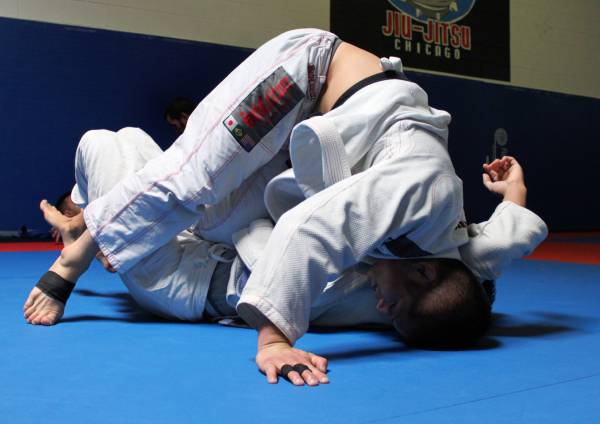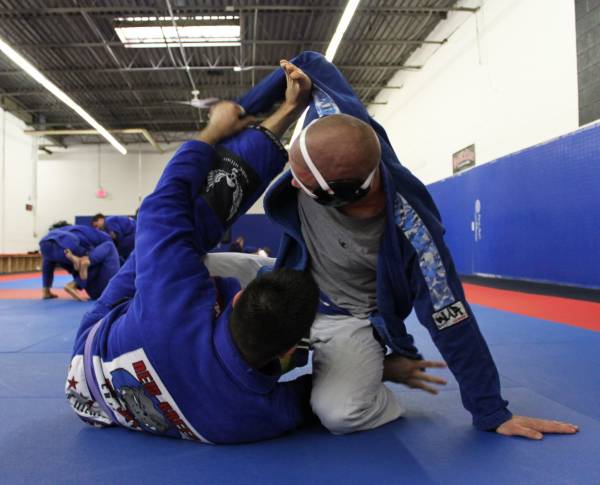I have been training Brazilian jiu jitsu for seventeen years. That’s 119 in dog years. So, not surprisingly, sometimes I feel like Spike, and sometimes newer grapplers remind me of his eager compatriot Chester. In this clip, Spike galumphs down the street, flanked by a hepped-up Chester, who tries to engage Spike in an activity.
I like to think that Spike genuinely likes Chester. Otherwise, why would he hang out with him? But Spike may have seen a few things in his day that promote his world-weariness and impatience. Of course this doesn’t justify him smacking Chester. (Does it? No, of course not. Just checking. I mean, nothing.)
If we imagine Spike and Chester as analogs for black and white belts and that the clip is about jiu jitsu, neither black-belt Spike nor white-belt Chester has cornered the market on the “correct” attitude. Each is authentic, and each is consistent with different phases of the grappling journey. Chester is newer and more excited, while Spike is more experienced and more aware of the cost-benefit ratio.
“BJJ has given me tremendous gifts, but it has also taken a heavy toll. I train differently now than I did when I was not as far along in my journey.”
As a long-standing student of BJJ, I still enjoy moments of Chester-like adoration, but my outlook has shifted toward a calmer, Spikier affection. BJJ has given me tremendous gifts, but it has also taken a heavy toll. I train differently now than I did when I was not as far along in my journey. And I know more than I did then, which puts me in a better position to answer the question – how should lower belts train with higher belts?
I do not speak for every higher belt, so I cannot say how they want lower belts to train with them. But I wager the following items have some universality. With that in mind, read on for a few observations about this question, targeted to lower belts.
Your Demeanor Communicates as Clearly as Your Words
Many times I have stepped on the mat to find myself facing a less-experienced grappler who sees the color of my belt and communicates with body language and energy, “I’m gonna get a piece of you.” The unspoken message is as tangible as Spike smacking Chester. This person intends to “win the training,” as my friend and business partner Hannette Staack would say. This is a person who appears to have nothing to lose and everything to prove, and who appears to view rolling with a higher belt as an opportunity not to learn, but to feed an ego.
I’m not talking about a competition match or class. I’m not even talking about hard training, which is awesome with good partners and attitudes. I’m talking about friendly open mats or regular class sessions where a lower belt locks onto a higher belt, onto beating that higher belt, like a heat-seeking missile locks onto a target.
“We who have been around many years have learned that not every match has to be contested as if lives hung in the balance. In some situations, simply working on the puzzle is perfectly fine.”
Sadly, at times I have probably been the missile myself. And of course, not every lower belt does this, and the ones who do may not recognize the energy they are giving off. But those on the receiving end do. We who have been around many years have learned that not every match has to be contested as if lives hung in the balance. In some situations, simply working on the puzzle is perfectly fine.
Many of us old-timers are also nursing longstanding injuries brought on by years of jiu jitsu. We work around these injuries so we can keep getting on the mat, which means we probably do not want to fight multiple steel-cage death matches. And finally, another reason that kind of energy can be tiring is because it is self-centered.
Continue to Page Two
Make Sure the Pace You Choose Suits Your Intentions
According to my unscientific longitudinal investigation, higher belts will let the lower belt they roll with set the pace. If the lower belt starts out collaboratively, the higher belt will do the same.
Conversely, if the lower belt comes on like a bat out of hell, the higher belt will ramp up. So, lower belts should choose a pace consistent with what they want to get out of the roll. And if they only have one pace, they might consider broadening their horizons.

If a less-experienced grappler comes at me full-bore, intent on winning the training, I resort to my Jiu Jitsu Hierarchy of Needs, and at this point, safety is at the tippy-top. Especially my safety. Especially if my partner has a different hierarchy.
For example: One time, I paired up with someone I outranked. Our roll started out pleasantly, but then I hit a sweep. As I was establishing top position, the energy between us took a 180. I sensed it, and then I heard this person mutter, “Oh, so that’s how it’s gonna be.” I immediately put distance between us, and when we squared off again, I pulled closed guard and broke this person’s posture with an overhook and a high guard. My partner spent the rest of the time working to regain posture, and I spent the rest of the time preventing it.
This was probably just as useful for my partner as it was for me – not at all useful. But I intended to keep myself safe. If I had it to do again, I would have stopped after hearing the comment, extended my hand, and said, “Thank you. I’m going to sit out the rest of the round,” rather than running out the clock. If my partner had it to do again, I hope a different intention would have won the day. But the point is, at this stage of my career, I am far less likely to take on that kind of energy.
“If a less-experienced grappler comes at me full-bore, intent on winning the training, I resort to my Jiu Jitsu Hierarchy of Needs, and at this point, safety is at the tippy-top.”
Every now and then I see or hear people complain when bigger and stronger people roll lightly with them, particularly if the smaller person outranks the bigger person. The complainers claim the bigger person is being disrespectful, because their higher rank indicates they can handle the heat, and the bigger person should respect that.
I think differently. When a lower belt – or anybody – who outweighs me by 100, fifty, or even twenty pounds starts slowly in a training session with me, my reaction is always, “Thank you.” I would much rather start this way than immediately be the target of a small asteroid. The fact that these people err on the side of caution suggests a jiu jitsu hierarchy like mine. My partner and I can always up the intensity, but if a roll starts at eleven, it’s already over the cliff. It’s like adding salt to a meal. If you use a little, you can always add more. But if you dump it on and then decide it was too much, you can’t take it away.

You Are One of Two People – Remember the Golden Rule
As grapplers become more experienced at jiu jitsu, they turn their attention outward. They become able to pay it forward, to share lessons learned with the people coming up after them. Maybe during training, the higher belt feeds the lower belt the setup for the technique that was taught that day. Or maybe the higher belt allows the lower belt to start in the position of his or her choice to gain practice in that position. Or maybe the higher belt shares insight about strategy, mindset, or overcoming setbacks. Progression through the ranks brings an increasing focus on others.
“It’s like adding salt to a meal. If you use a little, you can always add more. But if you dump it on and then decide it was too much, you can’t take it away.”
This awareness is likely to be less developed in less-experienced grapplers because it is a skill learned over time. But it is never too soon to start practicing that kind of awareness, just like we practice a technique. Higher belts want to get something out of an exchange too, so it is both people’s responsibility to recognize it is not just about them.
The World Is Full of Spikes and Chesters
I am not perfect at any of this. Sometimes I let my ego get the better of me and try to win the training. But after many years, I am better able to recognize it, even if after the fact. I’m not proud of these moments, but I am aware I am making a choice, suboptimal though it is. With this awareness, I can make a better choice next time. And sometimes I even do.
The BJJ world is full of various Spikes and Chesters, all with different preferences and levels of experience. Spikes, how do you want Chesters to roll with you? Chesters, what do you want to tell Spikes?
More Like This:
- The 5 Phases Every BJJ Newbie Goes Through
- Surviving (Socially) the Beginner Phase of BJJ
- 4 Ways to Be a Good Training Partner
- New on Breaking Muscle Today
Photos courtesy of Ana Nieves.






